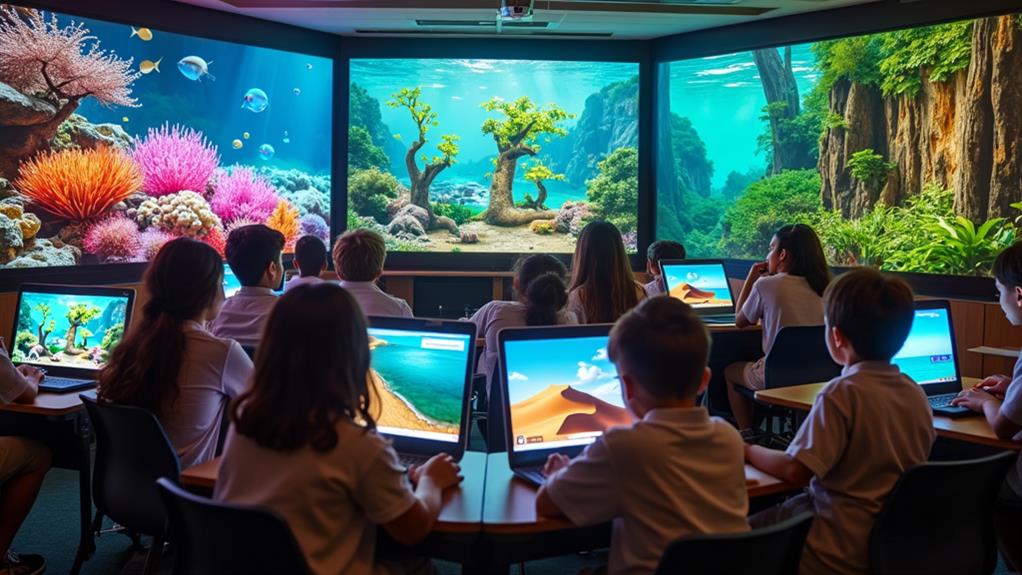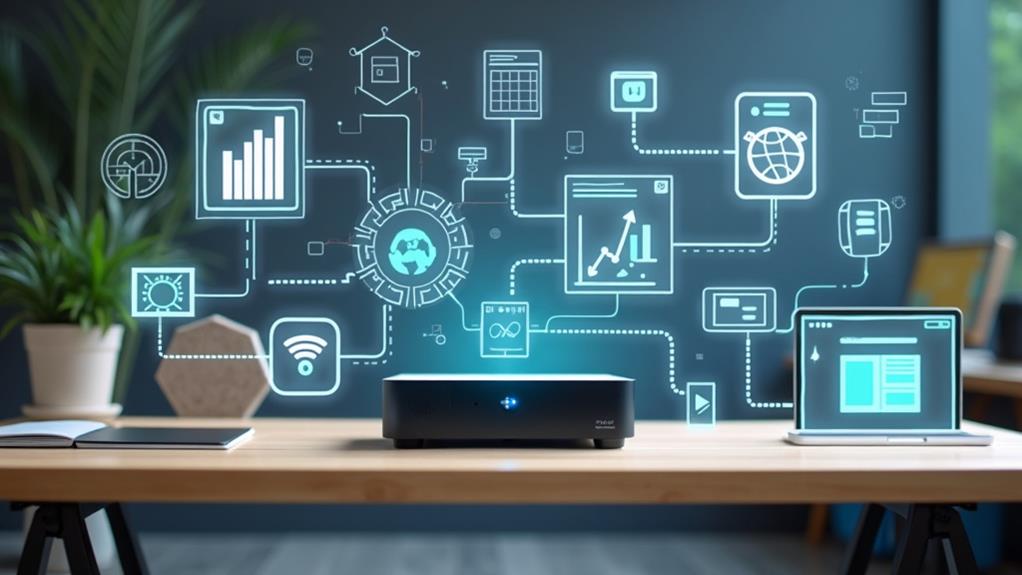Mini PCs operate effectively in low-resource settings due to their compact design and energy efficiency. They use less power—up to 50% less than traditional desktops—making them cost-effective for institutions with tight budgets. With efficient processors and SSDs, they're capable of handling basic tasks and ensuring quick access to data. Their multiple connectivity options support easy integration into existing systems, while their portability allows for transport to remote locations. Overall, mini PCs provide a versatile and sustainable solution for various applications. Keep exploring to discover more about their potential in underserved areas.
Key Takeaways
- Mini PCs consume significantly less power than traditional desktops, making them ideal for low-resource environments with limited energy availability.
- Their compact design allows for deployment in spaces where full-sized desktops cannot fit, maximizing usability in tight areas.
- Equipped with SSDs, Mini PCs provide fast data access and responsiveness, enhancing productivity in low-resource applications.
- Affordable and energy-efficient, Mini PCs help institutions manage budgets while effectively handling basic computing tasks.
- They offer versatile connectivity options, ensuring easy integration into existing systems and minimizing clutter through wireless connections.
Definition of Mini PCs
When you think about powerful yet compact computing solutions, mini PCs come to mind as a game-changer. These small form factor computers, typically less than one foot wide, deliver impressive performance without taking up much space. Emerging in the mid-2000s, mini PCs have gained popularity for their versatility and functionality. One of the first notable models, the Apple Mac Mini, aimed to provide an affordable and stripped-down option for users who needed a reliable computer without the bulk.
Mini PCs are designed with energy-efficient processors, such as Intel Celeron or AMD Ryzen, which greatly reduce power consumption while still handling everyday tasks like web browsing, document editing, and multimedia playback. Their compact size makes them ideal for various applications, including digital signage and home automation, as well as lightweight workstations in office environments. Mini PCs' durability is also bolstered by high-quality materials and innovative cooling systems, ensuring they can withstand the rigors of daily use.
Additionally, mini PCs come equipped with essential connectivity options like USB, HDMI, and Ethernet, making them adaptable for diverse use cases in low-resource settings. With their powerful capabilities and space-saving design, mini PCs are revolutionizing how we think about computing in limited environments.
Energy Efficiency Benefits
Energy efficiency is one of the standout benefits of mini PCs, making them exceptionally suitable for low-resource settings. These devices consume considerably less power than traditional desktop computers, often requiring less than 30 watts during operation. For instance, the Minisforum Mercury EM780 idles at just 15W, showcasing how mini PCs can operate effectively while minimizing energy use. This low power consumption not only reduces electricity costs but also makes it easier to work in areas with limited energy availability.
The compact size of mini PCs allows you to deploy them in spaces where full-sized desktops would be impractical or impossible. Many models in the mini PC market utilize energy-efficient processors like the Intel Celeron or AMD Ryzen, ensuring that you get adequate performance for everyday tasks while minimizing energy use. Additionally, their reduced heat output leads to lower cooling requirements, decreasing energy usage even further.
Performance in Low-Resource Environments
How do mini PCs perform in low-resource environments? Mini PCs, equipped with efficient processors like Intel Celeron or AMD Ryzen, deliver solid performance for essential tasks while consuming minimal power. For instance, models like the NAB7 Mini PC, powered by the Intel 12th Gen Core i7-12700H Processor, demonstrate exceptional multitasking capabilities even in compact designs. Their small size makes them perfect for cramped spaces, such as small offices or classrooms. You'll find that, with RAM capacities ranging from 4GB to 16GB, these devices handle light productivity tasks and web browsing with ease, even when resources are limited.
Moreover, mini PCs can utilize SSD storage, which boosts data access speeds and overall responsiveness—crucial factors in resource-constrained settings. This means you won't experience frustrating lag times while working. The energy-efficient design of mini PCs contributes to reduced heat generation, leading to lower electricity costs and a more sustainable operation. Additionally, the impressive visuals for tasks supported by mini PCs enhance the user experience, making them suitable for light gaming and multimedia projects.
In essence, mini PCs strike an excellent balance between performance and efficiency in low-resource environments. They provide the necessary computing power without the burden of high energy consumption, ensuring you can accomplish your tasks effectively, all while enjoying the benefits of their compact form factor.
Versatile Use Cases
Mini PCs are incredibly versatile tools that can adapt to a wide range of low-resource applications. Their small footprint allows you to place them in limited spaces, making them ideal for environments where every inch counts. Whether you're setting up digital signage to promote services or products, or using them as lightweight workstations, mini PCs deliver robust performance without the bulk.
Equipped with solid-state drives (SSDs), these devices guarantee fast data access, which is vital for applications that demand quick loading times. This feature is especially beneficial in low-resource settings, where efficient operation can greatly enhance productivity. You can easily integrate mini PCs into existing systems due to their various connectivity options, including USB and HDMI ports.
Their versatility doesn't stop there; mini PCs can also function as home automation hubs, controlling smart devices and enhancing daily living experiences. From educational institutions to small businesses, their adaptable nature allows them to fulfill multiple roles, proving that even in resource-constrained environments, technology can be both efficient and effective. With mini PCs, you have a powerful tool at your fingertips for diverse tasks.
Cost-Effectiveness for Institutions
For educational institutions and small businesses strapped for cash, mini PCs present an appealing solution that balances affordability with performance. These compact devices are typically less expensive than traditional desktops, making them a smart choice for those operating on tight budgets. Their small size allows for efficient use of limited space, helping you create more organized classrooms or offices.
Mini PCs are designed for energy efficiency, consuming considerably lower power than standard desktops. This translates to reduced electricity bills, with operational costs dropping by up to 50%. By choosing mini PCs, you not only save money upfront but also enjoy ongoing cost-effectiveness through lower energy consumption.
Equipped with the necessary processing power, many mini PCs can handle basic tasks effectively, enabling you to maximize your technology investments without overspending. Their longevity and lower maintenance requirements further contribute to overall savings, as they are easier to replace and maintain compared to traditional computers. In a world where every dollar counts, investing in mini PCs can help institutions stretch their budgets while still providing the technology needed for success.
Connectivity Options
When considering mini PCs for low-resource settings, their connectivity options play a vital role in maximizing their effectiveness. These compact devices typically come equipped with various connectivity options, including multiple USB ports and HDMI outputs, which allow seamless integration with peripherals and displays. For environments with limited network resources, many mini PCs support Wi-Fi 6 connectivity, ensuring faster and more reliable internet access.
In low-resource settings, the ability to connect to the internet efficiently is essential, and mini PCs excel in this regard. Plus, they often feature Bluetooth functionality, enabling easy connections to keyboards, mice, and printers without the hassle of tangled cables. This is particularly beneficial in resource-constrained environments where minimizing clutter can make a significant difference.
Additionally, some mini PC models, like Intel NUCs, can be customized with extra serial ports and other interfaces to meet specific needs in applications such as industrial automation or digital signage. Their compact size facilitates deployment in tight spaces, allowing you to set them up without requiring extensive infrastructure changes. With these versatile connectivity options, mini PCs prove to be effective tools in low-resource settings.
Comparisons With Traditional PCS
Many organizations in low-resource settings are discovering the advantages of mini PCs over traditional desktops. One of the most significant benefits is their impressive energy savings, with mini PCs consuming up to 50% less power. This reduction in energy use not only lowers utility bills but also aligns with sustainability goals.
In terms of space, mini PCs excel due to their compact size, easily fitting into limited environments without the need for extensive cooling solutions. Unlike traditional PCs, which generate more heat and require larger setups, mini PCs maintain adequate computing power for basic tasks using energy-efficient processors like Intel Celeron or AMD Ryzen.
When it comes to cost-effectiveness, mini PCs are generally more affordable than their traditional counterparts. This financial advantage makes them a practical choice for organizations operating within tight budgets. You'll find that mini PCs offer a reliable solution, delivering sufficient computing power while minimizing operational costs. Overall, the comparison highlights how mini PCs can be a smart investment for organizations seeking efficiency and sustainability in low-resource settings.
Challenges and Limitations
While mini PCs offer numerous advantages over traditional desktops, they also come with their own set of challenges and limitations that can impact their effectiveness in low-resource settings. One major issue is performance constraints; these devices often rely on low-power processors that might struggle with resource-intensive applications. This can hinder your ability to run essential software smoothly.
Additionally, limited internal storage can be a significant drawback. You might find yourself constantly managing available space, making it difficult to store large datasets or applications. The compact design of mini PCs also leads to thermal management challenges. Smaller cooling solutions can become ineffective during prolonged use, risking overheating and potential damage.
Moreover, mini PCs typically feature soldered components, which means you can't easily upgrade hardware when your needs evolve. This lack of flexibility can be frustrating in environments where increased power is required. Finally, connectivity limitations, such as fewer USB ports and a lack of expansion slots, can complicate the integration of multiple peripherals or additional hardware for specific tasks, further restricting your operational capabilities.
Future of Mini PCs in Resource-Limited Areas
The future of mini PCs in resource-limited areas looks promising, driven by their compact design and energy efficiency. These devices, which often utilize low-power ARM-based processors, consume considerably less electricity than traditional desktops. This makes them perfect for environments with limited power resources, allowing you to maximize computing capabilities without overloading the grid.
Affordability is another key factor. Mini PCs provide access to essential technology for organizations working in low-resource settings, alleviating the financial burden tied to full-sized desktops. Their versatility enables support for various applications, including digital signage, educational tools, and basic productivity tasks, empowering underserved communities with critical resources.
Additionally, the portability of mini PCs enhances their potential impact. You can easily transport them to remote educational facilities or mobile health clinics, ensuring technology reaches the people who need it most. As the demand for efficient computing solutions grows, mini PCs will likely play a fundamental role in bridging the digital divide in resource-limited areas. With their blend of energy efficiency, affordability, and versatility, mini PCs are set to transform how communities access and utilize technology in the future.
Disclosure: As an Amazon Associate, I earn from qualifying purchases.



